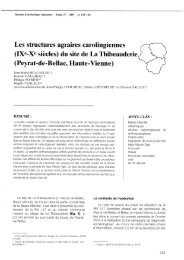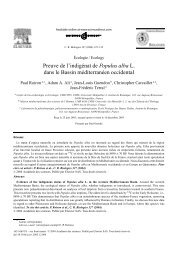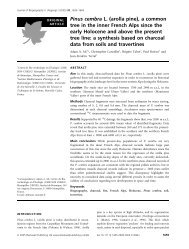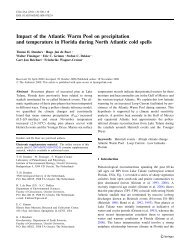The Egyptian olive (Olea europaea subsp ... - ResearchGate
The Egyptian olive (Olea europaea subsp ... - ResearchGate
The Egyptian olive (Olea europaea subsp ... - ResearchGate
You also want an ePaper? Increase the reach of your titles
YUMPU automatically turns print PDFs into web optimized ePapers that Google loves.
Claire Newton, Jean-Frédéric Terral & Sarah Ivorra<br />
the Levant to Crete and Greece during the Early Bronze Age, then to southern Italy (Brun<br />
2003: 128). <strong>The</strong> spread of oleiculture to northern Africa and Spain probably followed the<br />
Phoenician expansion (Brun 2003).<br />
To date, the oldest <strong>olive</strong> remains found in Egypt are charred stones from Thirteenth<br />
Dynasty Memphis (Kom el-Rabi’a, c . 1802-1640 BC) (Murray 2000: 610) and from the<br />
late Second Intermediate period Avaris in the Nile delta (Tell el-Dab’a, Thanheiser 2004,<br />
in press). <strong>The</strong>y probably represent imported fruit from the Eastern Mediterranean (Syro-<br />
Palestine), with which <strong>Egyptian</strong> trade was flourishing. <strong>The</strong> earliest <strong>olive</strong> wood identifications<br />
date to the New Kingdom (Asensi Amorós 2003). Stones, leaves and wood are found<br />
regularly from the New Kingdom onward (De Vartavan & Asensi Amorós 1997: 183-6).<br />
<strong>The</strong> leaves were used in garlands found in tombs from the New Kingdom, especially in the<br />
<strong>The</strong>ban area (Greiss 1966; Germer 1988, 1989), and the wood was used for the manufacture<br />
of coffins (Grosser et al. 1992). Finds from the workers’ villages of El-Amarna (Renfrew<br />
1985: 188) and Deir el-Medina (Bell 1982: 153) attest to their local consumption, although<br />
<strong>olive</strong>s must have been an occasional and luxurious food item.<br />
Eastern Mediterranean trade in <strong>olive</strong>s is demonstrated by the find of thousands of <strong>olive</strong>s<br />
and <strong>olive</strong> stones from a Late Bronze Age (late fourteenth century BC) shipwreck at Ulu Burun<br />
off the southern coast of Turkey, including a single deposit of more than 2500 stones in a<br />
Canaanite jar (Haldane 1993: 352). <strong>The</strong> ship, which sank during the Eighteenth Dynasty<br />
of the New Kingdom, also transported terebinth resin, identified also at the <strong>Egyptian</strong> New<br />
Kingdom site of El-Amarna (Haldane 1993). Iconographic and textual evidence also point<br />
toward the cultivation of the <strong>olive</strong> tree in Egypt during the New Kingdom (Meeks 1993).<br />
<strong>The</strong> texts also indicate that the produce was delivered almost exclusively to the temples and<br />
to the royal house (Haldane 1993).<br />
In Graeco-Roman times, the two main regions of cultivation for the <strong>olive</strong> tree would have<br />
been around Memphis, the Fayum and around <strong>The</strong>bes (Serpico & White 2000: 401). A<br />
document dating to 255 BC gives us an interesting clue concerning the varieties cultivated<br />
in Ptolemaic times; Apollonios, owner of an estate located in the Fayum, recommends<br />
grafting of <strong>olive</strong>s to his employee Zenon, in order to introduce Greek varieties to replace<br />
the <strong>Egyptian</strong> ones (P. Cairo Zen. 59184; Brun 2003: 128). Other documents from the<br />
Zenon archives mention several varieties grown in Egypt, in particular one ‘from Chios’<br />
(Brun 2003: 124). At the time that Pliny writes (first century AD), 15 varieties are recorded<br />
(Natural History XV: 15-7). Five of these bear large fruit suitable for pickling, including an<br />
<strong>Egyptian</strong> one. Finds of numerous <strong>olive</strong> presses at late Roman Akoris (third-fourth centuries<br />
AD), Middle Egypt, provide archaeological evidence for large-scale <strong>olive</strong> oil production at<br />
that time (Tsujimara 1995).<br />
Finds from Ptolemaic and Roman period sites include wood (Asensi Amorós 2001), and<br />
all types of remains from settlement contexts in the oases (Thanheiser 1999; Wuttmann<br />
et al. 1998). For the Roman period, <strong>olive</strong> remains are also found at sites where they could<br />
not have been grown, such as Berenike on the Red Sea coast (Cappers 1998) and praesidia<br />
(fortified stations) on the roads linking the Nile valley to the Red Sea ports (this study;<br />
Tengberg in prep).<br />
In spite of its social and economic importance, the history of <strong>olive</strong> cultivation in the<br />
eastern Mediterranean, and in Egypt in particular, is not known in any detail. Where and<br />
Method<br />
407













